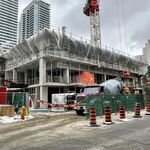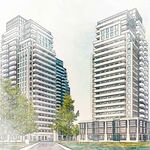This from the wonderful Lost Rivers website:
On the west side of the park is the highest hill in the Former City of Toronto (190 m high west of Avenue Rd.) and is the site of at least one Huron settlement, which is probably about 545 years old. Artifacts have been found over a wide area, including a number that were uncovered during excavations for Allenby Public School in 1927. Local residents continued to find material until the 1940’s. The size of the area over which the discoveries were made has been interpreted either as evidence for a very large settlement covering an area from Strathallan to Eglinton and from Bathurst to Duplex, or as evidence for a number of smaller settlements. Both the Huron and the European settlers cleared land for agriculture and housing, but the Huron occupied the land for shorter periods of time, and moved on when the soil was exhausted. The Huron used clay from the hillside for pottery and settlers used it for making bricks. Both had access to an abundant supply of water from the ceek and from springs in the hill (Ritchie, 1990, pp 16-19).
Today these springs on the west slope of the park keep the hill quite damp throughout the year. Springs occur where a porous layer of material (an aquifer) lies on top of an impervious layer. If the porous layer is thick enough and extends over a large enough area, sufficient water will accumulate to cause springs to flow year round. The formation in Eglinton Park consists of layers of sand topped with a layer of clay which was deposited in the last ice age.
T
he springs on the Eglinton Hill supplied water to the Town of North Toronto from about 1890 until 1902. A private company laid water mains east to Yonge Street, and north and south along Yonge. A steam driven pump raised the water from the well into a great overhead wooden tank lined with copper (on Roselawn west of Avenue Rd.). Gravity from the elevated tank provided the water pressure in the mains. There is a story about this tank bursting, and flooding the ‘whole area as far as Yonge Street). In 1896 excess steam from the pump began to be used to generate a direct electric current for arc lights along Yonge Street as far north as York Mills. In 1900 a second dynamo was connected to the system at the Roselawn Pumping Station, allowing incandescent lamps to operate in the town hall at Montgomery and Yonge. Shortly thereafter, a serious fire damaged the dynamos and alternate arrangements were made for electric power.
By 1901 the Eginton well was no longer able to provide an adequate supply of water to North Toronto, so an aquifer at
Sherwood Park was tapped. In 1912 the whole neighbourhood was hooked in to the city water system supplying water from Lake Ontario. (See
Toronto’s Water Supply)
The water tower, which continued to be used to provide pressure for North Toronto, was a landmark on the hill near the intersection of Avenue Rd. and Roselawn for many years. It was replaced in the 1950s with a steel tank. The transmission tower which stands on the site today is used by the water pumping stations for communication. (Information about the water tower supplied by Alex Grenzebach and Don Cross)


















